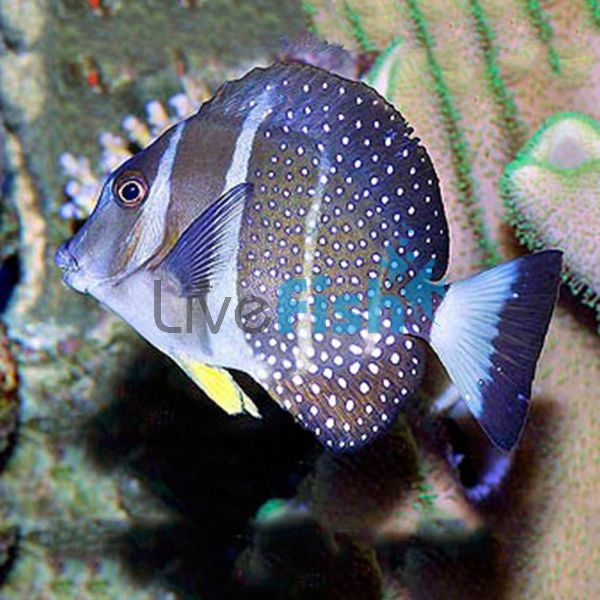Tang Mustard White Spot - Medium
The Mustard Tang is an attractive species and is one of the harder to find Tangs. It is an active swimmer that consumes tank algae and will make a great addition to any tank.
The Mustard Tang has a silvery face and grey body. The front half of its body has two thick silver bars running down it. The rear half has two thinner stripes and an assortment of white spots. The pelvic and tailfins have a pale yellow colouring with a dark edging. Once they reach maturity, adults can reach a length of 10 inches (26 centimetres).
There are no reports of home breeding for this species. In its natural habitat the Mustard Tang spawns all year round. Large groups will congregate at sunset to spawn on reef flats. This occurs near the outlet channel of reef flats, making good use of the seaward currents in that area.
Generally, it is an Indo-Pacific species, found in Mauritius, Indonesia, Japan and Australia. However, it has also been spotted off the Florida coast. It inhabits seaward reefs where there are surge zones, often in large schools. Depth range is usually between 3-25 feet (1-20 metres).
Tank Recommendations for the Mustard Tang
Tank size should be at least 250 gallons (946 litres).
The Mustard Tang can be housed in reef or fish only aquariums. However, it may nip at LPS corals if underfed. An established tank is preferable as the Mustard Tang will be able to graze on filamentous algae.
This species requires areas of large open space for swimming, as well as rocky areas for shelter. Live rock can be arranged in a sloping fashion, similar to its natural habitat. Water flow needs to be well oxygenated and should be quite strong with plenty of turbulence.
Suitable Tank Buddies
The Mustard Tang is semi-aggressive but is better with peaceful tank buddies.
It's quite territorial and may show aggression to members of the Acanthuridae family. It is best to only keep one Mustard tang in smaller aquariums.
Usually Compatible
Sometime Compatible
Conspecifics and other Acanthuridae family members may need monitoring. Caution is also advised with Batfish, Triggerfish, and Rabbitfish.
Rarely Compatible
Avoid fin nipping fish, and peaceful slow movers such as Seahorses and Pipefish.
Feeding Your Mustard Tang
The Mustard Tang is generally a herbivore, but it will eat meaty food that’s introduced. A suitable diet should consist of various vegetables, algae, and seaweed (Nori). Broccoli, lettuce, cucumber, spirulina, fresh macroalgae, and zucchini are ideal. Enriched vegetable flakes and frozen herbivore products are also popular. It should be fed small amounts 3 times per day.
| Scientific Name | Acanthurus Guttatus |
|---|---|
| Care Level | Moderate |
| Common Names | Mustard Tang, Whitespotted Surgeonfish, Whitespotted Tang, Mustard Guttatus Tang, Spotted Tang, Spotband Surgeonfish, Mustard Surgeonfish. |
| Diet | Herbivore |
| Fish Family | Acanthuridae |
| Lifespan (years) | 7 |
| Max. Length (cm) | 26 |
| Min. Tank Volume (l) | 946 |
| Origin | Indo-Pacific. Mauritius, Indonesia, Japan, Australia. Also spotted off the Florida coast |
| Reef Safe | Yes |
| Sociability | Semi-aggressive |
| Venomous | No |
| Water Conditions | 22.2 – 27°C (72 – 82°F), dKH 8-12, pH 8.0-8.5, sg 1.020-1.025 |




